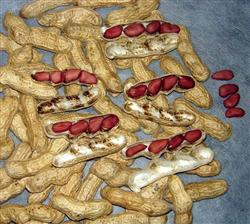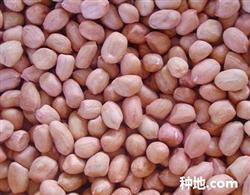How to fertilize peanuts scientifically?

How to fertilize peanuts scientifically? Please guide 1, the fertilization principle of peanut (1) the soil of cultivated peanut with the combination of organic fertilizer and inorganic fertilizer is mostly hill gravel soil and plain alluvial sandy soil. These soils have poor structure and low fertility, so organic fertilizers should be applied to activate the soil, improve the soil structure and improve the soil fertility, combined with the application of chemical fertilizers to supplement soil nutrients in time. In order to ensure the high yield and high quality of peanut, improve the efficiency of fertilization and achieve the combination of land use and land cultivation, we must implement the principle of combined application of organic fertilizer and inorganic fertilizer, learn from each other's strong points and complement each other, and give full play to the role of fertilizer in increasing production. (2) applying sufficient base fertilizer and proper topdressing base fertilizer will make the seedlings strong and peanut grow steadily, which lays a solid foundation for high yield and high quality. Peanuts can meet the needs of seedling rooting by increasing the proportion of nitrogen and potassium fertilizer. If the proportion of nitrogen fertilizer topdressing is too high, it is easy to cause overgrowth, inversion and diseases and insect pests; if the proportion of potash fertilizer topdressing is too high, it is easy to cause rotten fruit, and fertilizer returns are decreasing. Organic fertilizer and phosphate fertilizer with slow fertilizer effect and low utilization rate should be based on base fertilizer. Therefore, if we can apply sufficient base fertilizer at one time in peanut production, we can generally apply less or no topdressing. It is necessary to grasp the principle of "light application of strong seedlings, heavy application of weak seedlings, less application of fertile land and more application of thin land". 2. The fertilizer applied by base fertilizer and seed fertilizer combined with cultivated land preparation before sowing is called "base fertilizer" or "base fertilizer", and the fertilizer combined with sowing and opening ditches or holes is called "seed fertilizer". Base fertilizer and seed fertilizer are the basis of strong peanut seedlings, many flowers, many fruits and full pods. The amount of fertilizer generally accounts for 80% of the total amount of fertilizer applied, which is the main way of fertilization for peanuts. The base fertilizer should be based on mature organic fertilizer, combined with nitrogen, phosphorus, potassium and other chemical fertilizers, generally applying urea 20 per mu, superphosphate 100 kg per mu and potassium sulfate 30 jin per mu. 4000 jin of basic fertilizer is applied per mu. 3. Topdressing of peanut should be determined according to soil fertility, the amount of base fertilizer and the growth status of peanut. The main results are as follows: (1) the soil fertility of topdressing at seedling stage is low, the amount of base fertilizer is insufficient, and when the seedling growth is poor, seedling fertilizer should be applied early to promote the early development of seedlings. Topdressing at seedling stage should be applied before the first flowering stage, mainly nitrogen fertilizer and the combination of phosphorus and potassium fertilizer. General mu application of nitrogen fertilizer 8 Mu 10 kg, or compound fertilizer 30 Mu 40 jin, soil sprinkling or ditching strip application. (2) after topdressing peanut at flowering stage, the plant grows vigorously, a large number of effective flowers bloom, a large number of fruit needles go into the soil one after another, and the demand for nutrients increases sharply. If the basal fertilizer and seedling fertilizer are insufficient, topdressing should be done in time according to the appearance of peanuts. But at this time, the nitrogen fixation capacity of peanut rhizobia is strong, the amount of nitrogen fixation can basically meet their own needs, and the demand for phosphorus, calcium and potassium fertilizer is urgent, so the amount of nitrogen fertilizer should not be too much, mainly to topdressing phosphorus, potassium, calcium and fertilizer, so as not to cause excessive growth. Generally, 40 jin of calcium superphosphate and 500 jin of high-quality ring fertilizer are applied per mu to improve the nutrition of phosphorus and calcium of peanuts and increase production significantly. (3) foliar fertilizer spraying on peanut (also known as extra-root topdressing) has the effect of high absorption and utilization, fertilizer saving and yield increasing. Especially in the later stage of peanut growth and development, the root system is senescent and the effect of foliar fertilizer spraying is more obvious. Foliar spraying nitrogen fertilizer, peanut absorption and utilization rate of more than 50%; foliar spraying phosphate fertilizer, can quickly transfer to the pod, promoting pod fullness. In the later stage of peanut growth, 200 grams of potassium dihydrogen phosphate per mu was sprayed on the foliar surface of 120 jin of water, preferably three times in a row, every 7 days. Click to get more peanut planting technology click to get more grain and oil crop planting technology
- Prev

How to cultivate fresh peanuts
How to identify the advantages and disadvantages of peanut species? Please guide the current peanut preparation period, how to select improved peanut varieties is a matter of great concern to peanut growers. How to identify the advantages and disadvantages of peanut seeds, a few points are briefly introduced: first, look: good peanut seeds have full fruit, sharp embryo top, protruding bud disk and pink seed coat.
- Next

In what way can peanuts increase production?
What should we pay attention to before sowing peanut seeds? Please guide the graded sowing according to the grain size, so that the seeds sown will germinate neatly, and there will be no phenomenon of big seedlings pressing small seedlings and competing for fertilizer and water between big seedlings and small seedlings. Be careful not to damage the pericarp before sowing and drying the seeds that remove the peanut shell. Choose.
Related
- The first cup of black tea in spring, the flavor and history of tea gardens in Kenya, Africa
- The computer can not only choose potatoes, but also grow tea rice. AI will grow winter oolong tea champion.
- It is not only the inflated tea bitten by insects, but also engraved with the four seasons tea in Beipu.
- The Oriental Beauty Tea Festival in Zhuxian County takes the stage at the weekend to experience the plus-size feast of oil tea.
- & quot; Oriental Beauty Tea & Exploration of Emei in Hsinchu, the hometown of quot;
- The new variety of strawberry "Tainong 1" dessert is the first choice with mellow aroma. Crimson gorgeous
- History of Tea in Taiwan: from Wild Inner Mountain to Export Tea Garden
- Two types of Taiwan Oriental Beauty Black Tea won the British three-Star Award for Childhood Tea Xiang Zhang Jiaqi changed from pilot to champion tea maker.
- Banana species and varieties: the planting history of Taiwan Xianren banana and dwarf banana is long, is banana disease resistant?
- Coffee planting Technology: Qianjie Coffee from Seedling to harvesting

